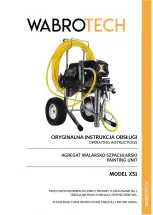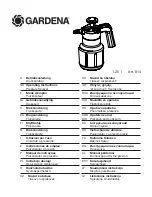
3
STOPPING
Move the ON/OFF switch by pushing the button on the side marked 0 (off).
When not working, switch the machine off and disconnect it from the power
supply.
WARNINGS AND OPERATING TIPS
After having read the safety standards carefully, apply these tips scrupulously
to obtain maximum performance from your machine. Work calmly. You will
only be able to make full use of the machines potential after gaining sufficient
experience. The painting conditions provided by this machine include a high
volume of air that directs the spray jet at low pressure, which provides greater
painting efficiency. In addition the stream of air shortens the drying time re-
quired for the coating material.
Grip the machine securely, put the support belt (where fitted) around your
neck and adjust it to suit your working position. The diagram in Fig. E illus-
trates the correct position.
WARNING! During use avoid obstructing the slots in the filter cover (9
- Fig. A).
Preparing the item or surface to be coated.
The spray painting result depends on the cleanliness and evenness of the surface
before spraying. Remove all traces of rust or old paint, and sand down if neces-
sary. Fill where necessary to provide an even surface. Remove all dust from the
surface before spraying. Read the instructions on the paint tin carefully, to check
whether it is possible to apply a bonding agent before painting for better results
and in order to use less paint. Surfaces that are not to be sprayed are to be
masked using adhesive tape or newspaper.
Preparing the material to be sprayed.
Shake the tin well before opening. Generally the paint to be used must be
diluted (we suggest testing a small amount of paint before diluting the entire
tin). Follow the paint manufacturers indications relating to the type of diluents
and quantity to be added. If the manufacturer does not indicate how their
product is to be diluted or what diluents to use, ask your paint dealer, being
sure to indicate that it will be applied using an HVLP (high volume, low
pressure) gun. Also take the following into account. The term viscosity is
used to indicate whether a substance is very liquid or very dense. The
viscosity is low for very liquid substances and high for more dense
substances. For an estimated viscosity to be associated with paints, where
no specific information is provided on the paint tin, see the viscosity table
TAB 1 below. Fill the tank (1 - Fig. G) for the gun to a maximum of ¾ of its
capacity. If necessary, add small amounts of diluents at a time after spraying
test patches on cardboard or a piece of wood.
TAB.1
Coating material
Viscosity (DIN-s)
Paints containing solvents
15-30
Basecoats
25-30
Mordants and primers
undiluted
2-component enamels and oil paint
20-35
Transparent enamels
15-25
Water dilutable paints
20-25
Vehicle coatings
20-25
Timber sealers
undiluted
Wall paint
16-20
Using the viscosity meter (13 - Fig. A)
This instrument indicates the viscosity in seconds. Mix the product and the
diluents well. Fill the viscosity meter (13 - Fig. A) with the substance to be
sprayed and count the seconds the liquid takes to flow out of the hole at the
bottom altogether (Fig. I). This period of time is the viscosity expressed in
DIN-seconds (DIN-s). Continue trying various dilutions until the correct vis-
cosity (DIN-s) for the given product is reached.
Adjusting the spray gun (Fig. G).
Fit the tank (1 - Fig. G) and close well. To choose the type of spray re-
quired (2 - Fig. H) slacken the regulating ring (3 - Fig. G) and adjust the
position of the butterfly nozzle (4 - Fig. G) in order to obtain (2 - Fig. H):
ELECTRICAL SAFETY STANDARDS
1)
Protect yourself against electrical shocks.
Avoid touching surfaces that
are earthed, such as hoses, radiators, etc. Do not use the machine if the
switch will not switch on or off. Get an authorised service centre to change
defective switches.
2)
Connecting to the power supply.
The power supply voltage must corre-
spond to that indicated on the technical data plate. Do not use any other
power supply. It is advisable to fit a trip switch on the power supply line
that trips at the levels laid down in standards currently in force in the
Country in which the machine is used. Contact your local electrician. Check
that the plugs and sockets used for the power supply are compatible.
3)
Do not damage the cable.
Never carry or move the tool by the power
supply cable and never pull the cable to disconnect it from the power
supply. To move the unit use the hand grip (3 - Fig. A) or the support belt
(5 - Fig. A where fitted). Do not pull it by the air hose (6 - Fig. A). Keep the
cable away from heat sources, oil or sharp edges.
4)
Check the power supply cable.
The power supply cable and plug must
be checked from time to time, and each time it is used to check for any
signs of damage or ageing. If these are not found to be in good condition
the machine must not be used until it has been repaired by an authorised
assistance centre
.
Only allow an authorised assistance centre to effect
any repairs to the electrical system.
5)
Extension cables.
Extension cables are to have a capacity that is equal to
or greater than that required for the machine. Use the cable connection (2
- Fig. A where fitted) specifically provided for an extension cable. Prevent
the extension cable from being trodden on or crushed. Check the exten-
sion cables from time to time and replace if damaged. Do not use exten-
sion cables that show signs of wear or ageing, as they may pose a fatal
hazard. Keep them away from the working area, damp, wet, or oily sur-
faces, or surfaces with sharp edges, heat sources, and fuels.
6)
Extension cables used out in the open.
When using the machine out-
doors, only use extension cables designed for outdoor use. Only use
extension cables that are tested and adequately marked.
7)
Warning.
Remove the plug from the power supply socket when the ma-
chine is not in use.
This machine has a double insulation system.
Double insulation provides greater electrical safety and makes it unnecessary
to earth the machine.
SETTING UP (FIG. C)
This machine may be supplied with some components not fitted. Remove the ma-
chine and the components supplied from the packaging and proceed to assemble
them as illustrated in the enclosed sheet.
While assembling the components the power supply plug must be discon-
nected from the power socket. Before starting the machine, check that all
assembled parts are properly secured.
FITTING THE GUN HOLDER (1) (where fitted)
When the gun holder is inserted a click must be heard.
FITTING THE AIR HOSE (2)
Complete the following steps, both on the machine casing side and the spray
gun side.
Insert the pipe coupling with the bayonet coupling (arrow a), turn (arrow b),
then pull (arrow c) to secure it properly.
FITTING THE SUPPORT BELT (3)
(where fitted)
Never use this machine without the air filter (11 - Fig. A).
STARTING AND STOPPING
Connect the extension cable to the cable connection (where fitted) and then
connect it to the power supply plug (Fig. D). Put the spray gun into the gun
holder (8 - Fig. A). Put the machine on the shoulder strap (Fig. E where fitted)
STARTING
Remove the gun from its holder and aim it in the direction of the surface to be
coated. Move the ON/OFF switch by pushing the button on the side marked I
(start). A continuous jet of air will flow out of the spray gun (7 - Fig. A) once
the machine has started. Regulate the spray and flow of material (see the
WARNINGS AND OPERATING TIPS paragraph). Press the trigger (8 - Fig. G).
8755388.p65
27/08/03, 17.17
3




































